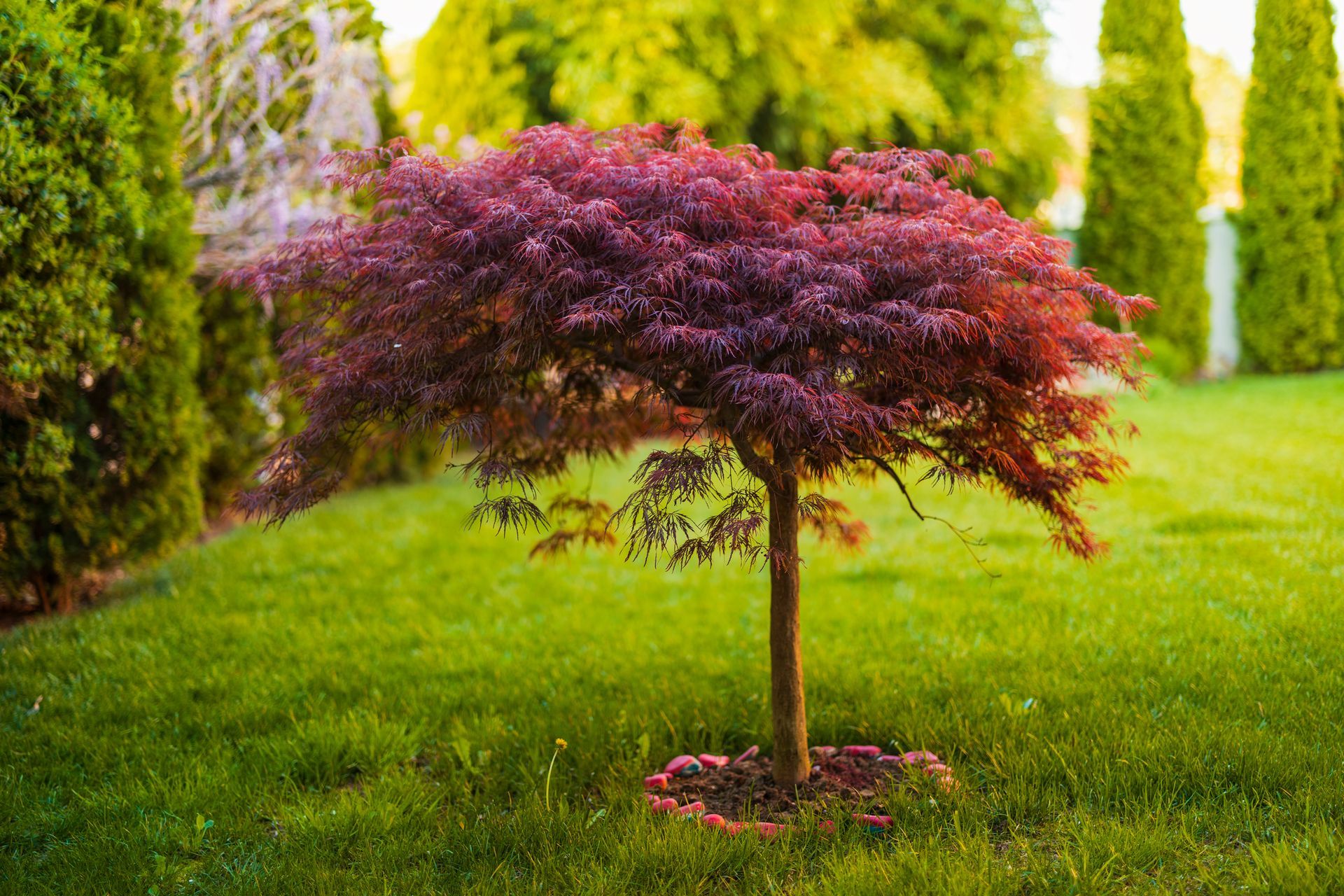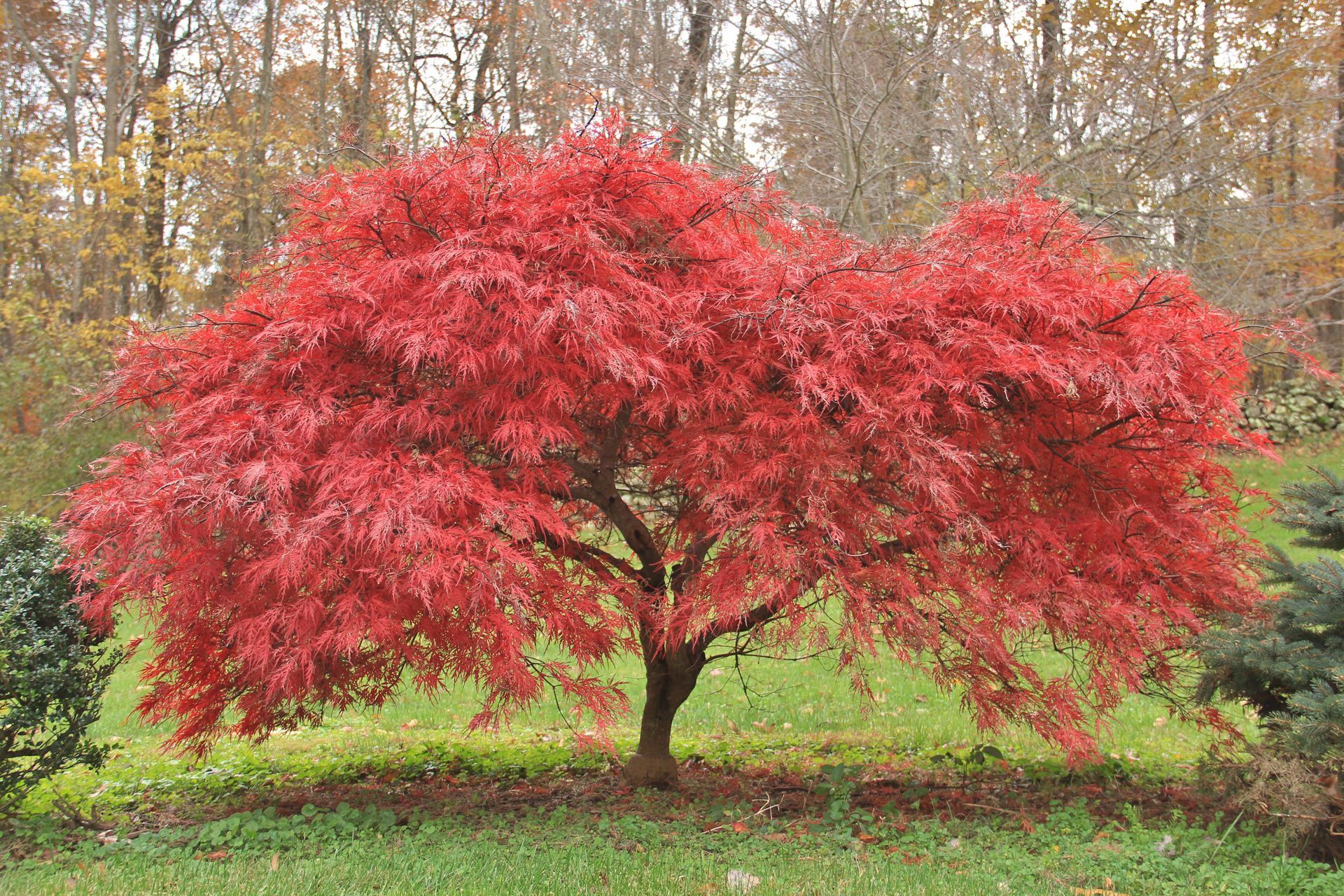Japanese Maple Tree Care

Japanese maple trees are a vibrant addition to your garden or front yard since they come in a range of foliage colors, including white, pink, red, green, and orange. Besides increasing your home's aesthetic value, they also shape your landscape and make excellent ornamental trees.
Fast Facts for Japanese Maple Trees
| Common Name | Smooth Japanese maple and palmate maple |
|---|---|
| Scientific Name | Acer palmatum |
| Month(s) of Harvest | September to October |
| Light | Thrives in sunlight but also needs shade. Maximum sunlight is necessary for the best foliage color. |
| Water | Needs heavy watering twice a week in average weather and three to four times in drought periods |
| Soil | Prefers well-drained and moist soil with slight acidity. Soil should be loamy and rich in organic matter. |
| Fertilizer | 1/10 lbs of nitrogen fertilizer for every 1 inch of Japanese maple tree diameter; start measuring the trunk's diameter at 4.5 feet from the ground |
| Pests | Codling moth, red spider mite, aphids, scale insects, and juniper-apple rust |
| Diseases | Anthracnose is the primary disease, but the tree may also experience Pseudomonas tip blight and Phyllosticta leaf spot |
| Growing Zone | 5 to 8; can also grow in warmer zones but may be susceptible to leaf scorch. |
Table of Contents
How To Take Care of a Japanese Maple Tree
Japanese maple trees come in different shapes and sizes. You can grow them as potted plants, bonsai, or trees. If you plan to do the latter, ensure you know proper Japanese maple tree care.
For instance, you should know when to plant Japanese maple trees. It's also important to be familiar with their pruning, soil, water, light, and fertilizer requirements.
Soil & Container
The first step in caring for Japanese maples is to give them the correct container and soil. Let's talk about the container first.
Any container with holes that can hold soil will work for most Japanese maples. But you can choose the material based on your preference.
Metal containers heat up quickly. So, they cannot protect the roots from extreme heat or cold, as well as cement or terracotta. Skip metal pots if you live in an area with harsh temperatures.
Terracotta is a good choice since it is breathable. But it may crack in freezing temperatures. Another option is plastic since it's durable and affordable. It's also lightweight, making it easy for you to carry the plant around.
But if you've got the budget for it, opt for ceramic containers. They keep the plant's roots safe and don't crack as easily as terracotta.
The size of the container will depend on the Japanese maple cultivar you've selected. Dwarf varieties need a five-gallon container. You may have to upgrade to a bigger container as the plant grows older.
For a full-sized Japanese maple tree, get a 20-gallon container. If possible, get a bigger size.
Let's get to the soil now. The Japanese maple prefers acidic and sandy soils. Good soil is a mixture of 30% native soil, 40% sand, and 30% peat moss. If the native soil isn't acidic, you can lower its pH value by fertilizing the plant using an organic acid-containing fertilizer.
Root Inspection
Before you repot the plant, make sure to inspect its roots. Gently remove the tree from its container and check for any dead or diseased roots. If you find any, cut them with a pair of scissors or your hands.
Also, look for circling roots. These will appear to be growing inward toward the trunk. You may have to wash the roots to see the precise trajectory of their growth.
Untangle circling roots so that they grow outward. Be gentle; you don't want to break any roots in the process.
Water Requirements
Watering frequently and on time is an integral part of Japanese maple tree care. Young trees have higher water requirements, so you should water them every 2 or 3 days in the initial months after planting.
After that, only water your tree once a week but use at least two gallons of water. Use this pattern for the first two years of the tree's growth.
The watering requirement may differ based on your tree's age, size, and the weather. To check if your tree needs watering, determine the soil moisture.
If possible, invest in a moisture meter. Or, use your fingers to check if the soil is over 1 inch dry. Only water if the soil is 1 or more inches dry.
After two years, the Japanese maple will have a robust root system that it can use to draw water from the soil. Do not water as often in autumn since the soil stays wet for longer.
Japanese maples do not need frequent watering in winter as they enter dormancy. You should only water when the soil is completely dry.
Fertilizing and Filling
Here are a few hard and fast rules about fertilizing Japanese maple trees:
- Do not fertilize a Japanese maple tree in its first year.
- After the first year, start with a small amount of fertilizer.
- Fertilize the tree in early spring.
- Do not use fast-acting or nitrogen-rich formulas since they promote unhealthy growth.
When choosing the suitable fertilizers for Japanese maple trees, you have two options:
- Organic: These fertilizers are naturally occurring materials, including bat guano, bone meal, and kelp meal. They provide primary and secondary nutrients to your plant.
- Synthetic: These nutrients mainly provide primary nutrients - nitrogen, potassium, and phosphorus - to plants. Since they come pre-mixed, you do not have to do any additional measurements.
If you're going to transplant your Japanese maple tree from a container to your yard, add two to three inches of organic material into the soil. After that, put the plant in.
Start fertilizing it from the second year of growth. The best time for fertilizing a Japanese maple tree is early spring before new leaves emerge.
Sun & Placement
Japanese maples prefer afternoon shade, especially in early growth years. However, they still need plenty of sunlight since it helps them establish a strong foliage color. Sun exposure also allows the trees to develop an open and loose structure, which is one of their notable characteristics.
Keeping this in mind, the best place to plant your Japanese maple tree is in an area with morning sun but afternoon shade. If the tree is placed in direct sunlight all day, its leaves will scorch quickly.
Similarly, if it doesn't get enough afternoon shade, its reddish-purple flowers will not be as vibrant.
Temperature and Humidity
Japanese maple trees thrive well in regions where the minimum temperature does not go below -10 degrees Fahrenheit. Some cultivars can tolerate temperatures up to -30 degrees Fahrenheit.
They like moderate humidity. While low humidity can dry out the leaves and cause them to curl up, too much moisture can make the tree susceptible to disease.
Pruning
Pruning is an essential component of Japanese maple care. Here's what you should know:
- Why: Pruning improves the aesthetic and health of a Japanese maple tree. You should remove dead, broken, and dying branches to enhance your tree's appearance. Every Japanese maple, regardless of the cultivar, needs pruning.
- When: Prune the Japanese maple tree in dormancy, which is in late winter. You can also do light pruning at other times throughout the year.
- Tools: You'll need a pair of sharp pruners and loppers for the job. Pruning saws are good to have on hand if you're dealing with thicker branches.
Now, let's get to the 'how' of pruning Japanese maple trees. Before you get into it, make sure you clean your pruning tools with a 90% alcohol solution or a bleach water solution to sanitize them. Sanitize your tools repeatedly to prevent the spread of infection.
Follow these steps to prune your tree:
- Start pruning from the lower branches. If you see branches with dissimilar leaves from the top, remove them.
- Remove dead or dying branches.
- Cut broken branches.
- Use hand pruners for branches with a diameter of 1/4 inch and loppers for thicker branches up to 2 inches. A pruning saw works best for branches thicker than 2 inches.
- Do not prune more than one-third of the Japanese maple tree per year.
- Make pruning cuts close to the tree's collar without cutting the collar itself.

Japanese Maple Tree Problems
Now that you know how to care for a Japanese maple, you should also be familiar with what can possibly go wrong. Here are some common problems growers face.
Not Flowering
There can be many reasons your tree is not blooming. Here are some common ones:
- Dead Branches: If the Japanese maple tree has dead branches, it's likely that they are hindering the tree from producing flowers. That's why pruning every year is essential.
- Lack of Sunlight: Japanese maples grow well in the afternoon shade. But they need sunlight for growing flowers. Make sure you plant the tree in an area where it can get early or late afternoon sun.
- Lack of Nutrients: Sometimes, you might think an all-purpose fertilizer is enough. But your plant may be lacking specific nutrients. In this case, you'll have to conduct a soil test. Then, replenish the nutrients your tree is missing.
- pH: Japanese maple trees require a slightly acidic soil pH. If the soil is neutral or alkaline, adjust its acidity for proper blooming.
- Late Frost: If a cold snap occurs in late spring, your plant may not flower since the frost damages buds.
Yellowing Leaves
If your Japanese maple tree has yellow leaves or yellow spots on leaves, a lot could be wrong. Keep an eye out for the following.
Maple Tar Spot
If the upper leaf surface of your Japanese maple tree is yellow-speckled, the tree might be harboring tar spot or Rhytisma fungus. It starts as yellow freckles but quickly develops into black spots.
Luckily, maple tar spot is not lethal. It does more damage to your tree's appearance than its structure.
The best management practices include:
- Raking up damaged leaves as soon as they fall from the tree
- Following proper cultural practices, such as proper pruning and fertilizing
- Applying a fungicide during the spring months to prevent infection
Phyllosticta Leaf Spot
Phyllosticta leaf spot is a fungal disease of Japanese maple trees caused by Phyllosticta minima. The symptoms include yellowish-brown lesions on the leaves.
Infection is common in early summer and spring, especially if it rains. The fungus mainly targets newly planted Japanese maple and lower branches.
If wet weather is anticipated, apply a chemical fungicide beforehand to keep your tree safe.
Mineral Deficiency
When Japanese maple trees do not have enough of these three minerals, they develop chlorosis, which is the yellowing of the leaves due to insufficient chlorophyll production.
- Zinc
- Iron
- Manganese
In minor cases, the condition will slow the tree's growth. But if your tree is majorly deficient, it can also die.
Consult an arborist to find the best fertilizer for your tree.
Leaf Scorch
Excessive exposure to full sun can result in yellow spots on Japanese maple leaves. The scorched leaves die and fall from the tree in a few days.
You can prevent leaf scorch by planting the tree in a partially shaded area. Also, water frequently in dry periods.
If your region gets excessively hot, place a 3-inch layer of pine bark mulch - ideal for soil cooling - to prevent sun damage.
Wilting Leaves
Your Japanese maple's leaves may be wilting because they are:
- Under drought stress
- Diseased
- Nutrient deficient
Fortunately, there's a fix for each problem. In periods of drought, supplemental water can help keep your Japanese maple well-hydrated.
If your tree is diseased, look for the signs of infection. Then, identify the disease and use the appropriate chemical treatment.
For example, a common disease of the Japanese maple is anthracnose. It affects Japanese maple trees in summer and spring since the fungal spores prefer warm and wet conditions. A mild spring season with a lot of rainfall is a flagbearer of anthracnose. Its symptoms include:
- Tan or cream-colored blotches on the leaf veins and margins
- Dead and crunchy leaves
- Tiny black spores on the blotches
Phyllactinia and Sawadaea are two fungal species that can cause the powdery mildew of the Japanese maple. Infection mainly occurs towards the end of the summer. Common symptoms are white and dusty growth on the leaf surfaces along with black fruiting bodies on their undersides.
The best way to treat fungal diseases is to use an appropriate fungicide. Also, prune away all affected branches and twigs as soon as you spot the disease.
As for nutrient deficiency, get your soil tested. The results will show which minerals are lacking and the amount of fertilizer needed to get your tree back in shape.
Damaged Leaves
Root rot is one of the leading causes of damaged leaves in Japanese maple trees. Pythium and Phytophthora are the main culprits behind this disease.
The first symptom of root rot is blacked, yellowed, and damaged leaves. After that, root and branch dieback occurs, often followed by tree death.
Prevention is the best cure for this condition. Do not plant Japanese maple trees in low-lying areas with a risk of water pooling after rain. Also, wait for the soil to dry before you plant Japanese maples.
If root rot occurs, remove the plant from the vicinity immediately so that it does not infect nearby trees. Some registered fungicides may be helpful, but they are only preventative.
Learning About Japanese Maple Trees
If you're a Japanese maple enthusiast, welcome to the club. Here are some cool facts about the tree.
- The Japanese maple fruit is called a samara, which produces tiny seeds named helicopter seeds. But the fruit isn't like an orange or apple. It's more like an acorn.
- Japanese maples grow at an exceptionally fast rate. Many cultivars can grow anywhere from six inches to a whole foot yearly.
- Some people actually eat Japanese maple leaves. Cover a Japanese maple leaf in a sugar batter and fry it to enjoy a delicious snack.
- There are thousands of cultivars of Japanese maple. So, you're spoilt for choice when choosing the best Japanese maple varieties for your garden.
Japanese Maple Trees Origin Story
The Japanese maple is native to southern Japan and southeast Korea. Most cultivars were initially developed in Japan back in the 1700s. But they only came to the western part of the world in 1820.
The first Japanese maple in the West was introduced in the UK. A Swedish doctor, Carl Peter Thunberg, went to Japan in the 1800s and brought a Japanese maple back.
Thunberg named the species 'palmatum' due to the palm-like leaf shapes. Today, the Japanese maple is popular in gardens worldwide, with many cultivars bred for their unique foliage and colors.
Did You Know? Growing Japanese maple trees in your backyard will make your home inviting to all sorts of birds. Japanese maple is a monoecious tree, which means it has male and female flowers. These flowers do not attract insects but are loved by songbirds, quail, and grouse. Meanwhile, chipmunks and squirrels love the tree's seeds.
Sweet New Earth's Final Word On Japanese Maple Trees
Summing up our Japanese maple care guide, we can recommend growing these trees for their brilliant fall color and ornamental value. They are one of the best front yard trees.
Besides the leaf color, many Japanese maples are known for their beautiful branching structure and unique leaf shapes. Plus, they're easy to care for as long as you give them the right conditions, such as morning sun, loamy potting soil, proper fertilizer, and frequent watering.
Here's a pro tip. If you plan to grow multiple trees together, Japanese maples pair well with Kalmias, Camellias, and Rhododendrons. Together, these plants will create a beautiful, low-maintenance garden lasting for years.

Christina Hernandez
Christina has done most of her research on environmental science but recently has changed her focus towards sustainable forestry. She has a passion for the outdoors and wants to spread that passion to the world.
Join our community!
Join to receive guides, insights, and the latest gardening deals!
